Pictures of the Century
A Little DEFA Feature Film History
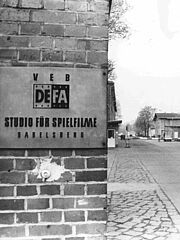
Entrance
of the DEFA Studio for Feature Films in Potsdam-Babelsberg; © DEFA-Stiftung/Siegfried Skoluda
The air outside was fresh. Sixteen degrees Celsius, very cloudy with some rain: not exactly a friendly May day. But inside the hall, the weather was immediately forgotten. Because in the Great Hall of the Babelsberg Althoff Studios, nothing less was up for debate than the eagerly awaited revival of German cinema. After twelve years under the authority of a propaganda minister who was as diabolical as he was obsessed with film, after six years of war and almost a year of film production hiatus, the first German film company was to be launched, which would serve all facets from feature and documentary films to cultural films. The name of the company: Deutsche Film Aktiongesellschaft (German Film Limited Liability), or DEFA for short.
In 1945/46, the Western Allies initially opposed new film production on German soil. Many filmmakers, so they argued, were rooted too deeply in the media landscape of the National Socialists. In addition, numerous American, English and French films were available for the re-education and entertainment of Germans. The Soviet Military Administration (SMAD), however, had other plans. As early as fall 1945, the Central Administration for Public Education, established by SMAD, launched a call for German filmmakers to get in touch and help restart film production. On October 29, 1945, Stalin allowed the head of the SMAD, Marshal Zhukov, to set up a German-Soviet joint-stock company for film production. On November 22, the new Film-Aktiv working group of the Central Administration for Public Education called for a meeting at the Hotel Adlon in Berlin. The participants of this meeting included directors Gerhard Lamprecht, Wolfgang Staudte, Peter Pewas and Werner Hochbaum, authors Friedrich Wolf and Hans Fallada and director Kurt Maetzig.
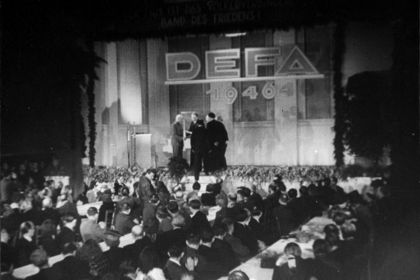
May 17, 1946: Founding event of DEFA in the Althoff Studios in Potsdam-Babelsberg; © DEFA-Stiftung

Hildegard Knef and Ernst Wilhelm Borchert in THE MURDERERS ARE AMONG US (DIE MÖRDER SIND UNTER UNS (Dir.: Wolfgang Staudte, 1946)) Photography: Eugen Klagemann
Noteworthy activities soon emanated from the Film-Aktiv. As early as February 19, 1946, the first newsreel of THE EYEWITNESS REPORT series was released. The first synchronizations of Soviet films were commissioned. The first DEFA documentary UNITY OF SPD AND KPD (EINHEIT SPD - KPD, 1946) directed by Kurt Maetzig, premiered on May 1, and on May 4, Wolfgang Staudte began filming THE MURDERERS ARE AMONG US (DIE MÖRDER SIND UNTER UNS, 1946), the first feature film.
One of the speakers at DEFA’s founding ceremony on May 17 was President of the Central Administration for Public Education Paul Wandel, who had returned to Germany from Soviet exile. He called on the filmmakers to take a stance on the „big questions of the fate of our people.“ „Film must no longer be the opiate of forgetting, but should give to all our people strength, courage, the will to live and zest for life. Above all, however, filmmaking must be sustained by an inner honesty that seeks the truth, proclaims the truth and shakes the conscience.“ Similarly, the Soviet Officer for Culture Sergei Tulpanov saw the new German film as „a sharp and powerful weapon against reactionary powers and for a true and growing democracy.“

Charles Knetschke and Harry Hindemith in SOMEWHERE IN BERLIN (IRGENDWO IN BERLIN (Dir.: Gerhard Lamprecht, 1946)) Photography: Kurt Wunsch

Paul Klinger and Ilse Steppat in MARRIAGE IN THE SHADOWS (EHE IM SCHATTEN (Dir.: Kurt Maetzig, 1947)) Photography: Kurt Wunsch
In its first year, DEFA released three feature films that dealt with Germany’s present and immediate past. THE MURDERERS ARE AMONG US (DIE MÖRDER SIND UNTER UNS, Wolfgang Staudte, 1946), a film about war crimes and German guilt, drew on elements of Expressionist cinema with its oblique camera perspectives and emphasis on light and shadow. FREE LAND (FREIES LAND, 1946) by Milo Harbich, a didactic report on the land reform in Mecklenburg that intervened in current social processes, combined documentary shots with performed scenes. Gerhard Lamprecht underpinned the realistic motifs of SOMEWHERE IN BERLIN (IRGENDWO IN BERLIN, 1946) with melodramatic pathos. In 1947, Kurt Maetzig directed MARRIAGE IN THE SHADOWS (EHE IM SCHATTEN), the first German film about the Holocaust. The film premiered simultaneously in all four sectors of Berlin. In the crime film THE BLUM AFFAIR (AFFAIRE BLUM, 1948), Erich Engel investigated the virulent antisemitism in the Weimar Republic. And Georg C. Klaren directed Georg Büchner’s drama fragment WOZZECK (WOZZECK, 1947) as a nightmarish, feverish indictment of militarism. Films on antifascism have remained important for DEFA in all decades and across all generations: melancholic and pathetic, analytical and allegorical. A cinema of enlightenment and study of political, social and psychological search for clues. Important directors, including Konrad Wolf (STARS (STERNE, 1959); PROFESSOR MAMLOCK (PROFESSOR MAMLOCK, 1961)) and Frank Beyer STAR-CROSSED LOVERS (KÖNIGSKINDER, 1962); NAKED AMONG WOLVES (NACKT UNTER WÖLFEN, 1963); JACOB THE LIAR (JAKOB DER LÜGNER, 1974); HELD FOR QUESTIONING (DER AUFENTHALT, 1983)) produced films that also attracted international attention, and Günther Rücker’s and Günter Reisch’s THE FIANCÉE (DIE VERLOBTE, 1980) received the Grand Prize of the Karlovy Vary Film Festival. Even the last generation of directors, who started at DEFA in the mid-1980s, made their contribution with stylistically remarkable, parabolic films such as STIELKE, HEINZ, FIFTEEN … (STIELKE, HEINZ, FÜNFZEHN ..., Michael Kann, 1986) or FIRST LOSS (ERSTER VERLUST, Maxim Dessau, 1990).
Many of these films describe events from the Nazi period, and only a few broadened the perspective to an officially undesirable investigation into the hidden afterlife of Nazi ideology in everyday life in the GDR, as in the suggestive drama THE SECOND TRACK (DAS ZWEITE GLEIS, Joachim Kunert, 1962).

Albert Hetterle in THE SECOND TRACK (DAS ZWEITE GLEIS (Dir.: Joachim Kunert, 1962)) Photography: Max Teschner

Kurt Meisel in WOZZECK (WOZZECK (Dir.: Georg C. Klaren, 1947)) Photography: Rudolf Brix
The production of WOZZECK created initial ideological controversies: Klaren’s imagery was not well received by Soviet advisors, who had a significant say in the early DEFA productions. They suspected the director of „formalism,“ a term that was often used in Soviet cultural policy to criticize or even ban formal experiments that did not submit to the canon of so-called „socialist realism.“ Formalism was something alien, menacing, intellectualist, something that supposedly did not correspond with the working class. Until the end of the GDR, formal experiments aroused suspicion among cultural and political decision-makers: from their point of view, a DEFA film financed by the state treasury had to be understandable, clear and unambiguous for everyone, and in no way influenced by „elitist“ artistic ambitions. This also explains why experimental approaches were rather rare at DEFA. But there are some films that stand out from the mainstream productions of that time: THE GLEIWITZ CASE (DER FALL GLEIWITZ, Gerhard Klein, 1961), about the fake Nazi attack on the Gleiwitz radio station that triggered World War II; the narratively free, unbound Egon Günther film THE KEYS (DIE SCHLÜSSEL, 1974), about the tragic journey of a couple to Kraków and the relationship between Poles and Germans; Konrad Wolf and Wolfgang Kohlhaase‘s episodic THE NAKED MAN ON THE SPORTS FIELD (DER NACKTE MANN AUF DEM SPORTPLATZ, 1974), about the relationship between the artist and society; the metaphorical YOUR UNKNOWN BROTHER (DEIN UNBEKANNTER BRUDER, Ulrich Weiß, 1982) about betrayal and fear in the antifascist resistance; or the symbolically exaggerated THE AIRSHIP (DAS LUFTSCHIFF, Rainer Simon, 1983) about the fatal entanglements of an inventor in the political events of his time.

Jutta Hoffmann in THE KEYS (DIE SCHLÜSSEL (Dir.: Egon Günther, 1973)) Photography: Klaus Goldmann

Uwe Kockisch and Jenny Gröllmann in YOUR UNKNOWN BROTHER (DEIN UNBEKANNTER BRUDER (Dir.: Ulrich Weiß, 1981)) Photography: Christa Köfer
On January 1, 1953, DEFA was dissolved as a central „film company with limited liability.“ Its assets were transferred to the legal entities of independent, state-owned companies: including the DEFA Studios for Feature Films, the DEFA Studio for Popular Science Films in Potsdam-Babelsberg and the DEFA Studio for Newsreels and Documentaries and Dubbing Studio in Berlin. On April 1, 1955, the DEFA Studio for Animation Films in Dresden was added. Anyone who wanted to make films in the GDR had to do so in these studios: they held the monopoly. By the end of the GDR, around 700 feature films and 450 fictional short films, 950 animation films, 2,000 documentaries and 2,500 periodicals such as newsreels had been produced.
The DEFA Studio for Feature Films, which soon became one of the largest employers in Potsdam with about 2,500 employees, initially relied primarily on personnel who had been working in the film industry before 1945. They all knew each other: the directors and the cameramen; the production and unit managers; set designers, sound engineers, gaffers, editors. Many of them lived in West Berlin. And until the border with West Germany closed in August 1961, it was easy to get to the Babelsberg film city from there. DEFA had to cope with a first exodus of artistic personnel in 1948 due to the currency reform introduced by the three western powers. Some people were able to negotiate contracts with DEFA that guaranteed them to be paid in West Marks, but these were exceptions. During its existence, DEFA had suffered from a shortage of foreign currency, which was a major handicap not only in purchasing modern film technology, but also in procuring Western color film material or when filming in Western countries.

Werner Peters in THE KAISER’S LACKEY (DER UNTERTAN (Dir.: Wolfgang Staudte, 1951)) Photography: Eduard Neufeld

Willy A. Kleinau and Erwin Geschonneck in THE AXE OF WANDSBEK (DAS BEIL VON WANDSBEK (Dir.: Falk Harnack, 1950) Photography: Erich Kilian)
The Cold War had an ideological impact on DEFA’s work. The production program, which until 1949 had left room for political enlightenment as well as entertainment films by former Ufa directors such as Hans Deppe or Arthur Maria Rabenalt, was brought more in line with official party policies. Between 1949 and 1956, all DEFA clips were subject to lengthy approval procedures by the SED Party Film Commission and similar committees, which believed that cinema should be an extension of agitation and propaganda. Ideological traps lurked everywhere; whoever got caught up in them had to fear being held politically responsible. These control mechanisms caused feature film production to shrink. While ten DEFA feature films were released in cinemas in 1950, only eight were released in 1951 and only six in 1952. Wolfgang Staudte’s masterpiece THE KAISER’S LACKEY (DER UNTERTAN, 1951), a satirical study of the German petty bourgeois and their obsessions, found itself in the company of films that looked more like illustrations of political editorials. The first film was banned in 1951: THE AXE OF WANDSBEK (DAS BEIL VON WANDSBEK), Falk Harnack’s debut, was withdrawn from cinemas a few weeks after its premiere. Soviet advisors believed the film made audiences sympathize with a Nazi executioner. It was not until the 1980s, after an urgent request from leading actor Erwin Geschonneck, that the original version was re-released.
In July 1952, the Politburo of the SED set standards for the work of DEFA under the title „For the Upswing of Progressive German Film Art.“ The party’s official advice from the SED film conference that followed emphasized that such films must be „typical of our time“ and the „representation of the positive hero.“ Critical realism was to be overcome; instead, the films should serve to „educate the working masses in the spirit of socialism.“ Director Richard Groschopp later spoke of the fact that „many creative sparks“ had been extinguished with these decisions and that „there were hardly any ideas left and consequently no screenplays.“ The production studios were deserted, the irregular production process and the regulations caused resentment.

Gérard Philipe in THE ADVENTURE OF TILL ULENSPIEGEL (DIE ABENTEUER DES TILL ULENSPIEGEL (Dir.: Gérard Philipe, 1956)) Photography: Waltraut Pathenheimer, André Manion

Simone Signoret and Yves Montand in THE WITCHES OF SALEM (DIE HEXEN VON SALEM (Dir.: Raymond Rouleau, 1957)) Photography: Roger Corbeau
Joseph Stalin died on March 5, 1953. In the years that followed, a political thaw came from Moscow to DEFA. Instead of the Film Commission, the Film Administration Center that allowed shorter administrative paths was installed at the Ministry of Culture. It even allowed the Babelsberg studio management to decide on the start of shooting for feature films for a few months in 1956. Only the approval of the finished film was reserved for the Film Administration Center. By the early 1960s, production had grown to more than thirty films a year. More and more films in traditional genres were produced: comedies and satires, crime and spy films, opera adaptations, revue films. The Studio became interested in international production partners. Guest stars such as Simone Signoret, Yves Montand, Bernard Blier and Jean Gabin came to Babelsberg and were cast for the German-French co-productions THE ADVENTURE OF TILL ULENSPIEGEL (DIE ABENTEUER DES TILL ULENSPIEGEL, Gérard Philipe, 1956), THE WITCHES OF SALEM (DIE HEXEN VON SALEM, Raymond Rouleau, 1957) or LES MISERABLES (DIE ELENDEN, Jean-Paul Le Chanois, 1958).
Although the distribution of DEFA films in the Federal Republic of Germany was extremely hindered by government decisions in Bonn, but also by increasing anti-communism, the feature film studio tried to continue to cultivate relations with West German film artists. With CAROLA LAMBERTI – ONE FROM THE CIRCUS (CAROLA LAMBERTI - EINE VOM ZIRKUS, Hans Müller, 1954) and the E.T.A. Hoffmann adaptation THE LADY OF SCUDERY (DAS FRÄULEIN VON SCUDERI, Eugen York, 1955), DEFA enabled the silent film star Henny Porten to make a late comeback. The young Götz George appeared in a comedy from the milieu of freshwater fishery, OLD BARGE, YOUNG LOVE (ALTER KAHN UND JUNGE LIEBE, Hans Heinrich, 1957). Rudolf Forster, as well as Gisela Trowe, made guest appearances in DEFA films. Because German-German co-productions were torpedoed by West German government agencies, the West Berlin film dealer and producer Erich Mehl acted as a middleman and, with the help of his Stockholm-based company Pandora, provided foreign currency for the payment of of West German actors.

Henny Porten in THE LADY OF SCUDERI (DAS FRÄULEIN VON SCUDERI (Dir.: Eugen York, 1955)) Photography: Eduard Neufeld

Götz George in OLD BARGE, YOUNG LOVE (ALTER KAHN UND JUNGE LIEBE (Dir.: Hans Heinrich, 1956)) Photography: Heinz Wenzel
Kurt Maetzig and Slatan Dudow went down in DEFA history as important directors of the 1950s. With THE COUNCIL OF THE GODS (DER RAT DER GÖTTER, 1950), Maetzig tried to capture the entanglement of German high finance in crimes of the Nazi regime in a film. In 1954/55, he directed two legendary feature films that were promoted to personality cult and commissioned by the state, ERNST THÄLMANN - SON OF HIS CLASS (ERNST THÄLMANN - SOHN SEINER KLASSE) and ERNST THÄLMANN - LEADER OF HIS CLASS (ERNST THÄLMANN - FÜHRER SEINER KLASSE), large-scale color productions about the leader of the Communist Party of Germany who was murdered by the Nazis in 1944. CASTLE AND COTTAGES (SCHLÖSSER UND KATEN, 1957) became a realistic and timely view of processes in agriculture after 1945. In 1959, Maetzig made DEFA’s first science-fiction feature film, Silent Star, a co-production with Poland.
Maetzig, as it turns out, is the DEFA director whose work most clearly reflects on political upheavals to which film was subject in the GDR. In times of cultural and political liberalism, for instance, the early DEFA years up to 1948, 1956 and 1964/65, he created outstanding works. But when dogmas intensified, his films failed aesthetically and proved to be extensions of agitation. Maetzig—also the founding director of the Potsdam-Babelsberg Film Academy since 1954—was smart enough to recognize this yet always willing to adapt, thus making himself an apologist of day-to-day politics. This showed his greatness and tragedy at the same time.

Fritz Tillmann in THE COUNCIL OF THE GODS (DER RAT DER GÖTTER (Dir.: Kurt Maetzig, 1950)) Photography: Gerhard Kowalewski

Paul Bildt in OUR DAILY BREAD (UNSER TÄGLICH BROT (Dir.: Slatan Dudow, 1949)) Photography: Erich Kilian
Slatan Dudow, who was one of the few remigrants among DEFA feature film directors who returned to East Berlin from exile in Switzerland, was another very important director. Many of his films allowed the utopia to coagulate into reality: Dudow’s DEFA debut OUR DAILY BREAD (UNSER TÄGLICH BROT, 1949) was considered an early example of socialist realism from the moment it was released. Due to the integrity and uncompromising attitude with which he defended film as art, Dudow acted as a role model for many younger directors.
In the 1950s, the foundation was laid for DEFA’s multi-faceted and celebrated production of children’s films. Its output included many imaginative fairy tale films with special effects and works devoted to German history or current problems of childhood and growing up. In addition to audience favorites such as Wolfgang Staudte’s THE STORY OF LITTLE MOOK (DIE GESCHICHTE DES KLEINEN MUCK, 1953), Siegfried Hartmann’s THE TINDER BOX (DAS FEUERZEUG, 1958), Walter Beck’s KING THRUSHBEARD (KÖNIG DROSSELBART, 1965) or Václav Vorlíček’s THREE HAZELNUTS FOR CINDERELLA (DREI HASELNÜSSE FÜR ASCHENBRÖDEL, 1974), sensitive everyday stories were always well received. Several directors dedicated themselves to children’s cinema, including Helmut Dziuba with his film SABINE KLEIST, 7 YEARS … (SABINE KLEIST, 7 JAHRE ..., 1982), Rolf Losansky with MORITZ IN THE ADVERTISING PILLAR (MORITZ IN DER LITFASSSÄULE, 1983) and Hannelore Unterberg with ISABEL ON THE STAIRS (ISABEL AUF DER TREPPE, 1983). The aesthetically sophisticated education about feelings through film produced lasting works for a young audience.

Libuše Šafránková in THREE HAZELNUTS FOR CINDERELLA (DREI HASELNÜSSE FÜR ASCHENBRÖDEL (Dir.: Václav Vorlíček, 1973)) Photography: Jaromír Komárek

Dirk Müller in MORITZ IN THE ADVERTISING PILLAR (MORITZ IN DER LITFASSSÄULE (Dir.: Rolf Losansky, 1983)) Photography: Klaus Zähler
The visual style of many DEFA films was shaped by Ufa traditions for a long time. Gerhard Klein and Wolfgang Kohlhaase broke away from this tradition with their Berlin films, ALARM AT THE CIRCUS (ALARM IM ZIRKUS, 1954), A BERLIN ROMANCE (EINE BERLINER ROMANZE, 1956) and BERLIN-SCHÖNHAUSER CORNER … (BERLIN - ECKE SCHÖNHAUSER ..., 1957), which used principles of Italian neorealism. The filmmakers went out of the studio into the streets and squares, cast lay actors and worked with coarse-grained newsreel film material to give the feature films a documentary and authentic look. Klein and Kohlhaase, together with Konrad Wolf, Heiner Carow, Günter Reisch, Frank Vogel and Frank Beyer, brought a breath of fresh air into the studio in the mid-1950s. These members of the second generation of DEFA directors took inspiration from the young cinema in the USSR or in Poland, borrowed from British Free Cinema and French cinéma verité and used modern, open narrative structures instead of traditional dramaturgy. Trained in the DEFA Young Talent Studio or at renowned film schools in Moscow or Prague, they were primarily concerned with a cinematic portrayal of everyday life in the GDR, but also produced remarkable antifascist films.
The Second Film Conference of the SED took place during a period in which the second generation of directors was establishing itself. In July 1958, the party leadership criticized DEFA yet again. This time, the party censored entertaining films, including the revue MY WIFE MAKES MUSIC (MEINE FRAU MACHT MUSIK, Hans Heinrich, 1958) and CASINO AFFAIR (SPIELBANK-AFFÄRE, Arthur Pohl, 1957). Fairy tale films like THE SINGING, RINGING TREE (DAS SINGENDE, KLINGENDE BÄUMCHEN, Francesco Remani, 1957) were accused of having bourgeois idealistic conceptions. This did not bother the young DEFA directors: they also considered these films superfluous and stuffy. However, they took notice when Konrad Wolf’s SUN SEEKERS (SONNENSUCHER, 1958), about the lives of workers in uranium mining in the GDR, was not released due to pressure from the Soviet authorities.

Ilse Pagé in BERLIN - SCHÖNHAUSER CORNER ... (BERLIN - ECKE SCHÖNHAUSER... (Dir.: Gerhard Klein, 1957)) Photography: Siegmar Holstein, Hannes Schneider

Ulrike Germer in SUN SEEKER (SONNENSUCHER (Dir.: Konrad Wolf, 1958)) Photography: Herbert Kroiss
The party kept the DEFA Studios on the short leash, and the conference was held several times in the over forty years of the studios’ existence, always following a similar pattern. The first and second film conferences were followed by the fateful 11th Plenary Meeting of the Central Committee of the SED in December 1965, which resulted in a ban of twelve DEFA feature films and increased control on documentaries and animated films. In November 1981, a fictitious letter to the editor from an Erfurt worker was printed in the comment column of the SED’s central organ, Neues Deutschland, which was enough to stop undesirable political and aesthetic tendencies in feature film production. Under the heading „What I Would Like More from our Filmmakers“ the letter read: „I feel too little pride in the great achievements of the working class and its party in alliance with all working people in our country. Where are the works of art that make people aware of what I call the titanic nature of the achievement of building, becoming, and growing in our stable and prosperous workers’ and farmers’ state?“
Such declarations proved that strong forces within the SED party leadership still regarded film less as an artform and more as a means of party propaganda. However, it would be wrong to conclude that there were dogmatic SED functionaries on one side of the barricade and courageous, resistant, even subversive filmmakers on the other. It was more complicated: there were conformists and brave figuress on both sides; not infrequently, two souls raged even in the heart of one individual. This is the only way to explain that the DEFA management and the Ministry of Film also paved the way for films that were quite daring in their analysis of social conditions and sensitivities. Those DEFA films that were banned in 1965/66 were made in a political climate characterized by an increasingly open confrontation with its own past and present, right up to the highest SED circles. The fact that old Stalinists repeatedly succeeded in suppressing the beginnings of a „democratic socialism“ or a „socialism with a human face“ is part of the tragedy of the GDR and DEFA.

Eberhard Esche and Renate Blume in THE DIVIDED HEAVEN (DER GETEILTE HIMMEL (Dir.: Konrad Wolf, 1964)) Photography: Werner Bergmann

Alfred Müller and Angelika Waller in THE RABBIT IS ME (DAS KANINCHEN BIN ICH (Dir.: Kurt Maetzig, 1965)) Photography: Jörg Erkens
After the building of the Berlin Wall in 1961, DEFA filmmakers and writers hoped that they could now reflect more openly on the problems in their own country. Stories that dealt with developments in the GDR in an increasingly sovereign manner were put forward. While fundamentally agreeing with the socialist path, the second-generation filmmakers attached importance to the disclosure of details worthy of criticism: DESCRIPTION OF A SUMMER (BESCHREIBUNG EINES SOMMERS, Ralf Kirsten, 1962) described the party’s influence on the private lives of its members; THE DIVIDED HEAVEN (DER GETEILTE HIMMEL, Konrad Wolf, 1964) reflected on the reasons why many young people had left the GDR before the Wall was built. In THE RABBIT IS ME (DAS KANINCHEN BIN ICH, 1965), Kurt Maetzig criticized the political opportunism of judges and prosecutors. Frank Vogel’s DON’T THINK, I’LL CRY (DENK BLOSS NICHT, ICH HEULE, 1965), about a high school graduate who sees himself being held in the leash of dogmatic school politics, and THE RABBIT IS ME were presented to the delegates of the 11th Plenary Meeting and immediately banned. The films that were also banned in the following months included works by Herrmann Zschoche (CARLA (KARLA, 1965 - 1990)), Egon Günther (WHEN YOU’RE GROWN UP, DEAR ADAM (WENN DU GROSS BIST, LIEBER ADAM, 1965/66 - 1990)), Gerhard Klein (BERLIN AROUND THE CORNER (BERLIN UM DIE ECKE, 1965/1966 - 1990)), Jürgen Böttcher (BORN IN ’45 (JAHRGANG 45, 1966 - 1990)), Kurt Barthel (MISS BUTTERFLY (FRÄULEIN SCHMETTERLING, 1965/1966 - 2020)) and Frank Beyer (TRACE OF STONES (SPUR DER STEINE, 1966)). Frank Beyer and Günther Stahnke (SPRING TAKES TIME (DER FRÜHLING BRAUCHT ZEIT, 1965)) were also fired from the studio.
As always after such attacks on creativity, DEFA artists were deeply insecure for a while. These incriminated films from 1965/66 remained banned until 1989 and were taboo. Hardly anyone mentioned them publicly.

Peter Reusse and Herbert Köfer in DON’T THINK I’LL CRY (DENK BLOSS NICHT, ICH HEULE (Dir.: Frank Vogel, 1965)) Photography: Jörg Erkens

Monika Hildebrand and Rolf Römer in BORN IN ’45 (JAHRGANG 45 (Dir.: Jürgen Böttcher, 1966 - 1990)) Photography: Roland Gräf
The third generation of DEFA filmmakers focused on contemporary stories that no longer aimed for the socio-critical panoramic view of the works incriminated by the 11th Plenary Meeting. Instead, they drew their creative potential from dealing with everyday life and family and the self-realization of the individual. These films were dedicated to moral and ethical questions of living together: Herrmann Zschoche’s LIFE FOR TWO (LEBEN ZU ZWEIT, 1968), Ingrid Reschke's DO YOU KNOW URBAN? (KENNEN SIE URBAN?, 1971), Roland Gräf’s MY DEAR ROBINSON (MEIN LIEBER ROBINSON, 1970), Lothar Warneke’s LIFE WITH UWE (LEBEN MIT UWE, 1974), Siegfried Kühn’s TIME OF THE STORKS (ZEIT DER STÖRCHE, 1971) and Rainer Simon’s half-hour episode, ORDINARY PEOPLE, of the film FROM OUR TIME (AUS UNSERER ZEIT, 1969).
A few years later, Simon presented TILL EULENSPIEGEL (TILL EULENSPIEGEL, 1975), a subversive parable on the relationship between power and violence. After his contemporary film JADUP AND BOEL (JADUP UND BOEL, 1981), which revolved around the truthfulness of remembering and questioned the self-sufficiency of political officials, was banned, he shot multilayered historical parables about the relationship between the individual and society, such as THE WOMAN AND THE STRANGER (DIE FRAU UND DER FREMDE, 1984) and THE ASCENT TO CHIMBORAZO (DIE BESTEIGUNG DES CHIMBORAZO, 1989). In 1982, Roland Gräf directed the satire EXPLORING THE MARK BRANDENBURG (MÄRKISCHE FORSCHUNGEN) and also turned to the ambivalent biography of writer Hans Fallada (FALLADA - THE LAST CHAPTER (FALLADA - LETZTES KAPITEL, 1988). Siegfried Kühn released the grotesque THE SECOND LIFE OF FRIEDRICH WILHELM GEORG PLATOW (DAS ZWEITE DES FRIEDRICH WILHELM GEORG PLATOW, 1973), which was only allowed to be shown in smaller GDR studio cinemas and was banned from export, and THE ACTRESS (DIE SCHAUSPIELERIN, 1988), about the Jewish theater in Berlin during the Nazi era. In films like ALL MY GIRLS (ALLE MEINE MÄDCHEN, 1980) and THE BICYCLE (DAS FAHRRAD, 1982), Iris Gusner and Evelyn Schmidt compared the projection and reality of female emancipation in the GDR. Lothar Warneke’s BEAR YE ONE ANOTHER’S BURDEN … (EINER TRAGE DES ANDEREN LAST ..., 1987), in which representatives of different worldviews enter into a peaceful dispute, became the biggest audience success.

Corinna Harfouch and Michael Gwisdek in THE ACTRESS (DIE SCHAUSPIELERIN (Dir.: Siegfried Kühn, 1988)) Photography: Norbert Kuhröber
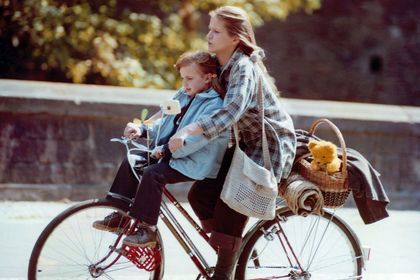
Anke Friedrich and Heidemarie Schneider in THE BICYCLE (DAS FAHRRAD (Dir.: Evelyn Schmidt, 1981)) Photography: Dietram Kleist
In addition, DEFA shot about a dozen Westerns, including FALCON’S TRAIL (SPUR DES FALKEN, Gottfried Kolditz, 1968) and FATAL ERROR (TÖDLICHER IRRTUM, Konrad Petzold, 1970), often in co-production with other East European film studios. Director Roland Oehme tried his hand at comedy. There were also respectable artist biographies and literary adaptations such as Horst Seemann’s BEETHOVEN - DAYS FROM A LIFE (BEETHOVEN - TAGE AUS EINEM LEBEN, 1976) or LEVIN’S MILL (LEVINS MÜHLE, 1980). In the 1980s, however, DEFA repeatedly came under political pressure: for example, with the youth films SWAN’S ISLAND (INSEL DER SCHWÄNE, Herrmann Zschoche, 1983) and YOUR PRESENCE IS IMPERATIVE (ERSCHEINEN PFLICHT, Helmut Dziuba, 1984). The films called for more intergenerational honesty and allowed their youthful heroes to have their own way in life off the beaten track. But these films were heavily criticized for this perspective. In view of these criticisms, many filmmakers hid their own critical attitude toward the present in historical stories, such as Michael Gwisdek’s directorial debut ENCOUNTER IN TRAVERS (TREFFEN IN TRAVERS, 1989), about a revolution that freezes in lethargy and discouragement.
The works of Heiner Carow, a former student of Slatan Dudow, stood out from the majority of DEFA productions in the 1970s and 1980s, much like the films of his teacher. His equally poetic and anarchistic THE LEGEND OF PAUL AND PAULA (DIE LEGENDE VON PAUL UND PAULA, 1973), a cult film to this day, pleaded for a self-determined life, as did his films ICARUS (IKARUS, 1975) and COMING OUT (COMING OUT, 1989), the first and only DEFA feature film to deal with the social problems of homosexuals. This theme that was also picked up in successful portraits of women such as HER THIRD (DER DRITTE, Egon Günther, 1972), SABINE WULFF (SABINE WULFF, Erwin Stranka, 1979), SOLO SUNNY (SOLO SUNNY, Konrad Wolf, 1980) and ON PROBATION (ENTLASSEN AUF BEWÄHRUNG, Herrmann Zschoche, 1981).

Gojko Mitić in FALCON’S TRAIL (SPUR DES FALKEN (Dir.: Gottfried Kolditz, 1968)) Photography: Waltraut Pathenheimer
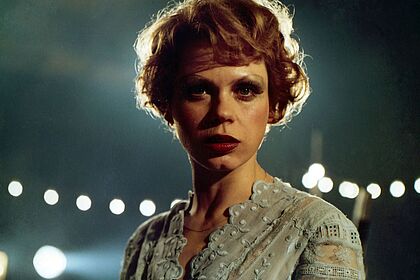
Renate Krößner in SOLO SUNNY (SOLO SUNNY (Dir.: Konrad Wolf, 1978 - 1979)) Photography: Dieter Lück
Despite this variety of films, the author and director Günther Rücker once made an apt remark: „the actual history of DEFA consists of its unrealized projects.“ Rücker’s statement referred to the countless film ideas and proposals that were never made into films, and by no means only for political reasons. In the early years, for example, Hans Fallada was commissioned to adapt his story The Quangels (Every Man Dies Alone) for a film project. For years, there was talk of an opulent production of Jacques Offenbach’s Beautiful Helena, adapted by Peter Hacks and directed by Egon Günther. The chief dramaturge Klaus Wischnewski traveled to Paris in 1965 to negotiate an adaptation of Jorge Semprún’s legendary concentration camp novel The Long Voyage. Two of Heiner Carow’s major projects were never realized: The Nibelungen and Simplicissimus, both based on screenplay drafts by author Franz Fühmann. Kurt Maetzig’s plan of adapting Heinrich Mann’s Henri IV for DEFA, pursued for more than twenty years, also remained unfulfilled. These were just a few spectacular projects. Rücker wanted not only to highlight individual film proposals, but rather to point out that, when thinking about DEFA, one should also consider what had been thought about for decades. Because a chronicler will be only able to get really close to the intellectual and aesthetic potency of the studios when considering the interplay of what was filmed and what was thought.
Of course, it would have been a huge effort for DEFA to realize a major project like Simplicissimus. That a film project like this was not impossible has been proven many times, for example in the 1960s, when DEFA managed to set up its own 70mm production independent of foreign countries. This made the GDR the only country besides the USA and the USSR with a complete production line for this 70mm technology. A total of eight 70mm feature films and two documentaries were made by DEFA, including the colorful adventure spectacle CAPTAIN FLORIAN OF THE MILL (HAUPTMANN FLORIAN VON DER MÜHLE, Werner W. Wallroth, 1968), the artist biography GOYA (GOYA, Konrad Wolf, 1970), the operetta ORPHEUS IN THE UNDERWORLD (ORPHEUS IN DER UNTERWELT, Horst Bonnet, 1974) and the political-poetic declaration of love to the GDR, YOU ARE MINE – A GERMAN DIARY (DU BIST MIN, Annelie and Andrew Thorndike, 1969). These films were intended to make cinema more attractive—not least because many viewers had migrated to their home television screens. However, DEFA could not and did not want to shut itself off from television. Since the early 1960s, more than twenty television films per year were commissioned to use the studio’s full capacity and to earn money. From time to time, the DEFA Studio also took on commissioned works from the Federal Republic of Germany, which brought in foreign currency for the state (but not for the studio): THE HEATHENS OF KUMMEROW (DIE HEIDEN VON KUMMEROW UND IHRE LUSTIGEN STREICHE, Werner Jacobs, 1966) was followed by e.g., SPRING SYMPHONY (FRÜHLINGSSINFONIE, Peter Schamoni, 1983) and THE GRÜNSTEIN VARIANT (DIE GRÜNSTEIN-VARIANTE, Bernhard Wicki, 1985), which was filmed in Babelsberg.
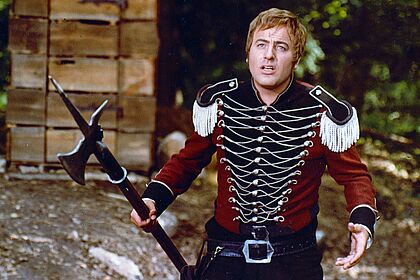
Manfred Krug in CAPTAIN FLORIAN OF THE MILL (HAUPTMANN FLORIAN VON DER MÜHLE (Dir.: Werner Wolfgang Wallroth, 1968)) Photography: Heinz Wenzel

Rolf Hoppe in ORPHEUS IN THE UNDERWORLD (ORPHEUS IN DER UNTERWELT (Dir.: Horst Bonnet, 1973)) Photography: Herbert Kroiss
At the end of 1989, after the fall of the Berlin Wall, the technical and economic staff of the DEFA Studio for Feature Films rebelled for the first time in over forty years against film projects that they said were no longer up to date. Stagehands, decorators and lighting technicians called for an „independent commission“ whose members should be democratically elected by the workforce which would decide on the planned films. Projects were to be judged according to market standards. In spring of 1990, it became clear that the DEFA Studios would no longer be supported by the state. Even the great idea of Detlev Rohwedder, president of the Treuhandanstalt (trust agency), which was responsible for the privatization of state-owned property in the former GDR to support DEFA as a cultural beacon of the GDR with federal funds for a transitional period of several years, had no chance. (Rohwedder was assassinated in April 1991.) THE ARCHITECTS (DIE ARCHITEKTEN, Peter Kahane, 1990) was one of the last premieres of a GDR film. It was a ruthless reckoning for the then 40-year-olds who had little chance of finding fulfillment in the country into which they were born. THE ARCHITECTS turned out to be the key film of the fourth and final generation of DEFA directors, who started after their studies to „splash some acid on the polished group portrait of ’real existing socialism,’“ as Kahane said, but far too rarely got a chance.
With the start of economic and monetary union, the Treuhandanstalt was installed by the GDR government and given the task of also transferring the DEFA Studios from state-owned enterprises to the market economy. Large swaths of the artistic staff lost their jobs. Thanks to subsidies from the last GDR Ministry of Culture and, beginning in October 1990, from the newly established federated state committees, the last film projects were able to get off the ground. For example, Jörg Foth shot the clown act LATEST FROM THE DADAER (LETZTES AUS DER DA DA ER, 1990), and Herwig Kipping the political farce THE LAND BEYOND THE RAINBOW (DAS LAND HINTER DEM REGENBOGEN, 1991). In addition, DEFA supported some filmmakers to whom it felt a moral obligation: Egon Günther, Ulrich Weiß, Frank Beyer, Roland Gräf, Helmut Dziuba, Evelyn Schmidt and Heiner Carow.

Kurt Naumann in THE ARCHITECTS (DIE ARCHITEKTEN (Dir.: Peter Kahane, 1990)) Photography: Christa Köfer
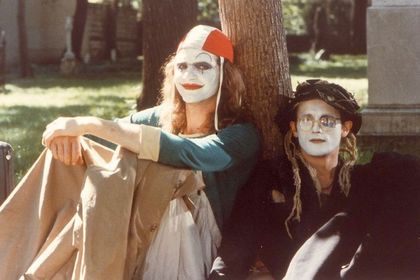
Steffen Mensching and Hans-Eckardt Wenzel in LATEST FROM THE DA-DA-R (LETZTES AUS DER DA DA ER (Dir.: Jörg Foth, 1990)) Photography: Thomas Plenert
None of these „last films“ were successful with the public. But, little by little, their value as contemporary documents and key works of lost utopia and traumatic upheaval was discovered. The DEFA films, which have always been a mirror of the history of ideas, politics and ethics and the constraints and ambivalences of its time, are today an undoubted part of German film and cultural heritage. This legacy is preserved in all its facets by the DEFA Foundation and shared with audiences.
Written by Ralf Schenk. (Mai 2021)

